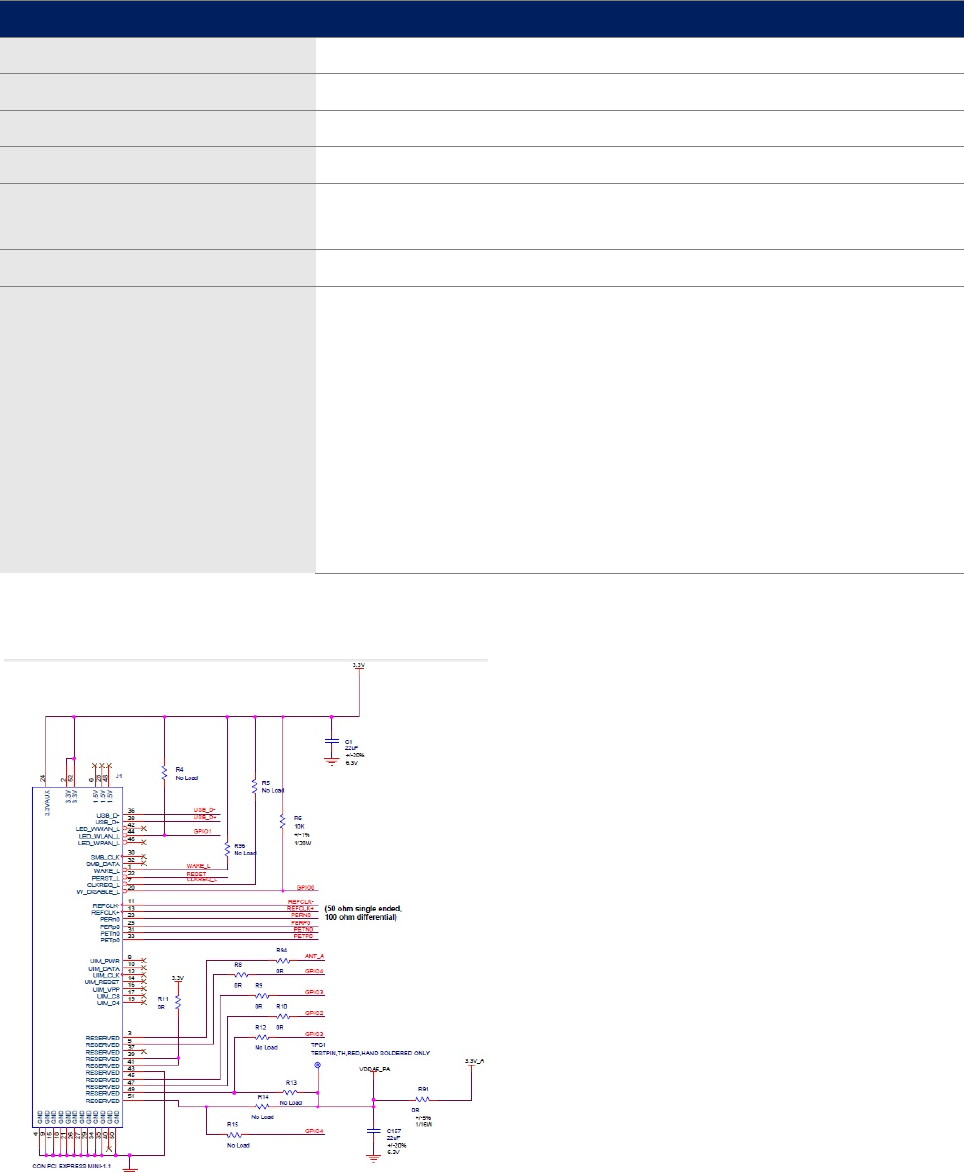Senao Networks PCE4551AH 802.11a/n/ac Module User Manual WUG2650 MNL
Senao Networks, Inc. 802.11a/n/ac Module WUG2650 MNL
Contents
- 1. user manual
- 2. User Manual
- 3. Users Manual_rev
Users Manual_rev
802.11 a/n/ac Module
PCE4551AH
User’s Manual
- 1 -

PRODUCT DESCRIPTION
The PCE4551AH is a 5G dual band concurrent 3T3R PCIe module base
on QCA9890 solution.
PRODUCT SPECIFICATION
RF
Sp
ec
i
f
i
c
a
t
i
o
n
Radio
1
Support
5
G
H
z
Interface 64-bit PCI-E
Operating Voltage 3.3V
Antenna Connectors I-PEX
Frequency
B
and
802
.
11a
/
n/ac
5.190~5.795GHz
Data
r
a
t
e 1300Mbps
Receive
Sensitivity
(
Ty
p
i
ca
l
)
802.11a
≤ -94dBm@6Mbps
≤ -76dBm@54Mbps
802.11a/ n_HT20 ≤ -93dBm @ MCS0/8/16
≤ -74dBm @ MCS7/15/23
802.11n_HT40 ≤ -92dBm @ MCS0/8/16
≤ -72dBm @ MCS7/15/23
802.11ac_HT80 ≤ -89dBm@MCS0
≤ -64dBm@MCS9
PRODUCT Pin Define
- 2 -

Type
Connector
5150~5250MHz
5250~5350MHz
5470~5725MHz
5725~5850MHz
Dipole
RPSMA
3dBi
3dBi
3dBi
3dBi
Dipole
RPSMA
5.5 dBi
5.5 dBi
5.5 dBi
5.5 dBi
PIFA
UFL
6 dBi
6 dBi
6 dBi
6 dBi
PIFA
UFL
5.5 dBi
5.5 dBi
5.5 dBi
5.5 dBi
Note: The EUT has three antennas. (3TX/3RX)
Any changes or modifications not expressly approved by the manufacturer could void the user's
authority to operate this equipment.
USERS MANUAL OF THE END PRODUCT:
In the users manual of the end product, the end user has to be informed to keep at least 20cm separation
with the antenna while this end product is installed and operated. The end user has to be informed that
the IC radio-frequency exposure guidelines for an uncontrolled environment can be satisfied. The end
user has to also be informed that any changes or modifications not expressly approved by the
manufacturer could void the user's authority to operate this equipment. IC statement is required to be
available in the users manual: This Class B digital apparatus complies with Canadian ICES-003.
Operation is subject to the following two conditions: (1) this device may not cause harmful interference
and (2) this device must accept any interference received, including interference that may cause
undesired operation.
- 3 -
Federal Communication Commission Interference Statement
This equipment has been tested and found to comply with the limits for a Class B digital device,
pursuant to Part 15 of the FCC Rules. These limits are designed to provide reasonable protection
against harmful interference in a residential installation. This equipment generates, uses and can radiate
radio frequency energy and, if not installed and used in accordance with the instructions, may cause
harmful interference to radio communications. However, there is no guarantee that interference will not
occur in a particular installation. If this equipment does cause harmful interference to radio or television
reception, which can be determined by turning the equipment off and on, the user is encouraged to try to
correct the interference by one of the following measures:
- Reorient or relocate the receiving antenna.
- Increase the separation between the equipment and receiver.
- Connect the equipment into an outlet on a circuit different from that to which the receiver is
connected.
- Consult the dealer or an experienced radio/TV technician for help.
FCC Caution: Any changes or modifications not expressly approved by the party responsible for
compliance could void the user's authority to operate this equipment.
IMPORTANT NOTE:
FCC Radiation Exposure Statement:
This equipment complies with FCC radiation exposure limits set forth for an uncontrolled environment.
This equipment should be installed and operated with minimum distance 20cm between the
radiator & your body.
This transmitter must not be co-located or operating in conjunction with any other antenna or transmitter.
Operations in the 5.15-5.25GHz band are restricted to indoor usage only.
The devices listed below have been originally approved under FCC rule part 15.247. Based on the
implementation of the rule changes from docket 13-49 these devices can no longer be manufactured,
sold, imported or placed into operation after June 2, 2016.
After this date these devices must comply with the new rule changes provided in docket 13-49.
The Memorandum of Opinion and Order issued on March 6 allows for these devices to be updated from
15.247 to compliance with new rules 15.407(b)(4)(ii) so long as there are no hardware changes or
changes to output power.
Devices approved under 15.407(b)(4)(ii) may be sold until March 2, 2020.
The following devices approved under 15.407(b)(4)(ii) may be marketed, sold and imported until March
2, 2020. After this date these devices must comply with the emission limits of 15.407.
- 4 -

This device is intended only for OEM integrators under the following conditions:
1) The antenna must be installed such that 20 cm is maintained between the antenna and
users, and
2) The transmitter module may not be co-located with any other transmitter or antenna,
As long as 2 conditions above are met, further transmitter test will not be required. However, the OEM
integrator is still responsible for testing their end-product for any additional compliance requirements
required with this module installed.
IMPORTANT NOTE: In the event that these conditions can not be met (for example certain laptop
configurations or co-location with another transmitter), then the FCC authorization is no longer
considered valid and the FCC ID can not be used on the final product. In these circumstances, the OEM
integrator will be responsible for re-evaluating the end product (including the transmitter) and obtaining a
separate FCC authorization.
- 5 -

End Product Labeling
This transmitter module is authorized only for use in device where the antenna may be installed such
that 20 cm may be maintained between the antenna and users. The final end product must be labeled in
a visible area with the following: “Contains FCC ID: U2M-PCE4551AH”.
- 6 -

Manual Information To the End User
The OEM integrator has to be aware not to provide information to the end user regarding how to install
or remove this RF module in the user’s manual of the end product which integrates this module.
The end user manual shall include all required regulatory information/warning as show in this manual.
- 7 -
Professional installation instruction
1. Installation personal
This product is designed for specific application and needs to be installed by a qualified
personal who has RF and related rule knowledge. The general user shall not attempt to install
or change the setting.
2. Installation location
The product shall be installed at a location where the radiating antenna can be kept 20 cm from
nearby person in normal operation condition to meet regulatory RF exposure requirement.
3. External antenna
Use only the antennas which have been approved by the applicant. The non-approved
antenna(s) may produce unwanted spurious or excessive RF transmitting power which may
lead to the violation of FCC limit and is prohibited.
4. Installation procedure
Please refer to user’s manual for the detail.
5. Warning
Please carefully select the installation position and make sure that the final output power does
not exceed the limit set force in relevant rules. The violation of the rule could lead to serious
federal penalty.
Professional installation instructions include power setting for collocation antennas and are
provided to qualified installation person for module setting up.
- 8 -